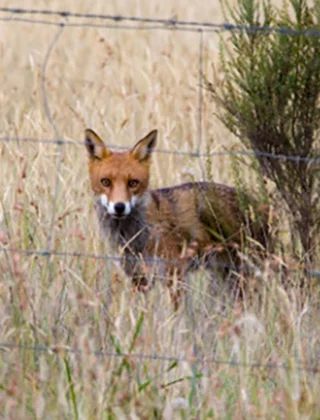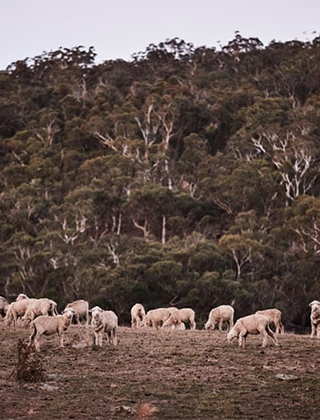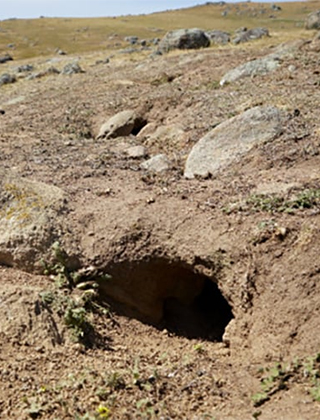Apply best practice IPM for rabbit control
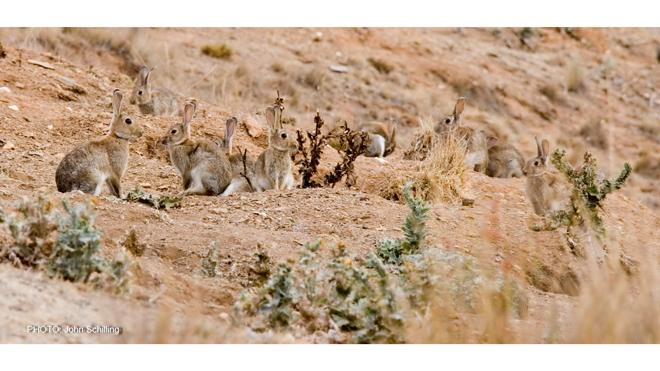
An analysis of rabbit control in Australia has revealed that only 39% of land managers undertook integrated pest management (IPM) when managing rabbits, whilst 61% used just one control technique. In light of these results, woolgrowers are urged to rigorously apply best‑practice IPM when controlling invasive rabbits and not regard RHDV biocide release as a ‘silver bullet’ solution.
Fast facts
- An analysis of rabbit control reports in Australia indicates that most land managers (61%) used only one rabbit control technique, rather than a combination of control methods (‘integrated pest management’) which is best practice.
- The analysis indicates land managers incorrectly perceive RHDV biocide release to be a ‘silver bullet’ control method.
- More effective pest management could result if integration principles were more rigorously applied.
European rabbits are Australia’s most widespread and destructive agricultural and environmental vertebrate pest.
Infesting two-thirds of Australia, and almost all wool-growing regions, rabbits cost Australia on average $217 million a year in lost farm productivity. They affect wool-growing productivity due to lower stocking rates and/or reduced sheep weight gains, wool cuts and birth rates. Rabbits are also the single biggest menace to threatened native species.
Effective management of rabbits is essential to protect agriculture and the environment. Since the early 1970s, integrated pest management (IPM) has been recommended as a means to not only efficiently reduce rabbit numbers, but also achieve their complete elimination at local scale, reducing the need and cost to frequently reapply control. IPM is not just about applying multiple controls; they must be applied in a sequence and at a time of the year that makes economic and ecological sense.
However, a recent analysis of 7,415 rabbit control records voluntarily submitted to RabbitScan by land managers between 2009–2021 found evidence of IPM in only 39% of the reports. In other words, most managers (61%) used only one control technique, rather than applying a well-considered sequence of integrated methods, as is recommended.
The extent to which integration occurred depended on the control method applied. Two of the four major rabbit control methods were frequently integrated with at least one other method; 73% of warren ripping and 55% of poison baiting records were associated with another different control method.
In contrast, only 15% of rabbit haemorrhagic disease virus (RHDV) releases and 35% of warren fumigations were integrated with another different control method.
Lead researcher Dr Pat Taggart of Bush Heritage Australia says the analysis, which was published in January in the Journal of Pest Science, confirmed anecdotal reports that land managers incorrectly view RHDV biocide release as a ‘silver bullet’ and release it to avoid applying more expensive but more effective control methods.
“Land managers should apply additional mechanical or chemical control methods, including the destruction of rabbit warrens and their above-ground harbour, or directly killing the rabbits by poisoning, fumigation of burrows, or shooting,” Dr Taggart said.
“RHDV is not a silver bullet and we need private and public land managers to be vigilant in not taking their foot off the pedal when it comes to regular mechanical or chemical rabbit control.”
- Dr Pat Taggart, Bush Heritage Australia
Furthermore, the researchers identified rabbit control sequences being applied that were neither biologically appropriate nor cost-efficient.
“A greater level of rabbit control and at a proportionally lower cost could result if IPM principles are more rigorously applied, for instance, by focusing on the strategic application of control methods in sequences known to be highly effective and cost-efficient,” Dr Taggart said.
Apply control methods in sequence
The sequence of control methods is critical for achieving a high level of rabbit management.
Furthermore, the control methods should be applied in as short a time sequence as feasibly possible, although sufficient time must be given for the first applied control method to have impact before the second control method is applied.
1. Population knockdown
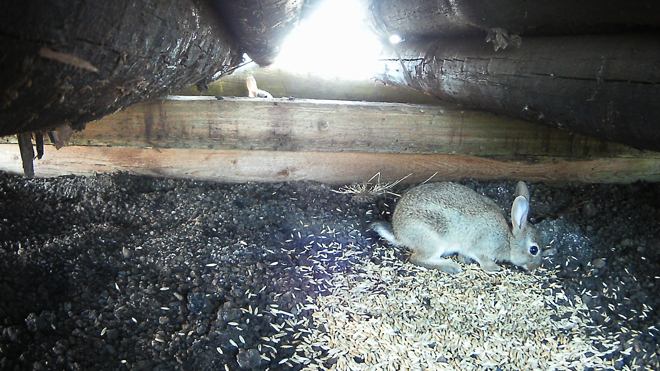
A rabbit eating oats laced with RHDV. PHOTO: CISS
The first step is to reduce the rabbit population from medium–high densities down to a manageable level. This is usually done by biological control (via natural outbreak or deliberate release) and/or chemical control (eg a poison baiting program) during the non-breeding season.
Myxoma virus is no longer produced commercially. RHDV is the current biological control and can be deliberately released in some areas (subject to state and territory legislation). RHDV is one of the more humane methods of controlling wild rabbits.
If RHD or myxomatosis are already present, then poison baiting should be delayed to allow the disease to reduce rabbit numbers. If rabbit density is low then extensive control can be started straight away.
2. Extensive control
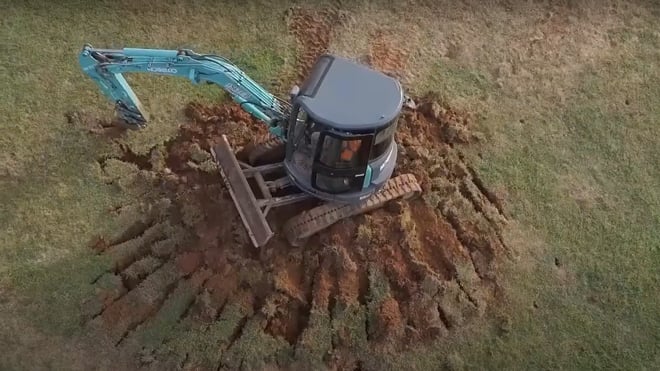
Rabbit warren ripping (the image is from an AWI video available at www.wool.com/rabbits).
The next part of the control program should destroy all source areas (where rabbits are living) and reduce rabbits to very low numbers. Control activities include warren ripping and destruction/removal of harbours which provide rabbits with shelter, such as fallen logs, building debris or dense vegetation. Where the use of heavy machinery is not an option for warren ripping, alternative techniques such as explosives may be used.
Extensive control ensures that the rabbit population cannot recover quickly but it must be done thoroughly to ensure success. If any warrens or harbour are not destroyed, rabbit numbers will simply build up again. Sometimes rabbits can also dig back in and ‘re-open’ warrens if ripping is not done thoroughly (deep or wide enough) and the collapse of the warren structure is inadequate.
3. Mop-up activities
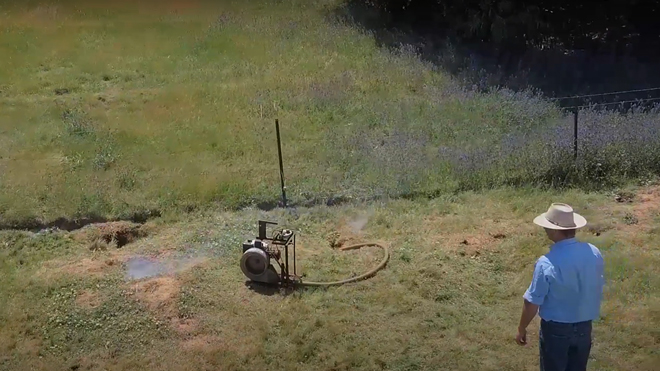
Rabbit warren fumigation (the image is from an AWI video available at www.wool.com/rabbits).
There are usually small numbers of rabbits that survive extensive control, so advanced control is necessary for long-term management. This is where follow-up techniques such as warren fumigation, shooting and trapping are used in rabbit-active areas.
Timing is crucial!
Applying control activities at the right time of the year is as important as the sequence through which controls are applied.
The implementation of integrated rabbit management in late summer-autumn (February-May), immediately prior to breeding and before winter rains begin, is a well-established recommendation for rabbit control.
This is consistent with when rabbit numbers are naturally at their lowest in their annual cycle and food is short, making rabbits more likely to consume baits treated with RHDV, pindone or 1080. This timing also facilitates effective warren ripping in light soils by improving the flow of soil into burrows to ensure their collapse.
It is important to note that RHDV should only be released when young rabbits are not present. This is because they do not develop acute disease and are immunised rather than killed by RHDV infection, thereby exacerbating Australia’s rabbit problem.
Therefore, RHDV should not be released across southern agricultural Australia between July and December (ie when young rabbits are likely to be present) unless land managers are confident rabbits are not breeding and young rabbits are not present. The optimal time of release is generally considered to be the end of summer or start of autumn (February, March, April), before any major autumn rainfall that might kickstart rabbit breeding.
More information:
- The Journal of Pest Science article is available (behind a paywall) at https://doi.org/10.1007/s10340-023-01720-7
- www.wool.com/rabbits
- The AWI co-funded, 36-page Glovebox Guide for Managing Rabbits provides useful information on best practice rabbit management for farmers and other land managers. Access the guide and other rabbit control related information on the PestSmart website www.pestsmart.org.au
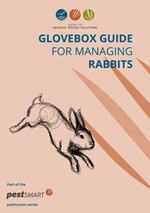
Monitoring rabbits using RabbitScan
RabbitScan is a free digital resource that Australian sheep and wool producers, plus other landholders and stakeholders, can use to record and access information about rabbit populations in their local area.
What to record:
- Rabbit activity (such as sightings and warrens)
- Damage, such as soil erosion
- Control activities
- Disease in rabbit populations (such as RHDV).
Benefits of using RabbitScan
- Develop a property or local area map of rabbit activity to guide control efforts
- Work together with your neighbours to undertake coordinated control
- Notify your local community or landholder group about rabbit activity and disease presence
- Send alerts to nominated people, such as neighbours or biosecurity authorities.
RabbitScan is available as an interactive website and mobile phone app, both of which have been designed to be simple to use.
AWI Program Manager Vertebrate Pests, Ian Evans, says RabbitScan is a collaboration tool that can help woolgrowers and other local stakeholders monitor and stay informed about rabbits in their area, thereby assisting them to apply best practice control.
“Used effectively, RabbitScan can provide woolgrowers and other community decision makers with accurate and timely information about the distribution and problems associated with rabbits. This information is very valuable for guiding local management decisions on how and when to control the pest animals,” Ian said.
“AWI encourages all landholders to monitor their rabbit populations and report through RabbitScan rabbit sightings, activity and deaths. The more people in a local area that use RabbitScan, the more useful it becomes.”
RabbitScan is part of the FeralScan™ suite of tools for monitoring pest animals. It receives funding from AWI, the Department of Agriculture, Fisheries & Forestry and NSW DPI through the Centre for Invasive Species Solutions (CISS).
More information: www.rabbitscan.org.au
This article appeared in the June 2024 edition of AWI’s Beyond the Bale magazine. Reproduction of the article is encouraged.






